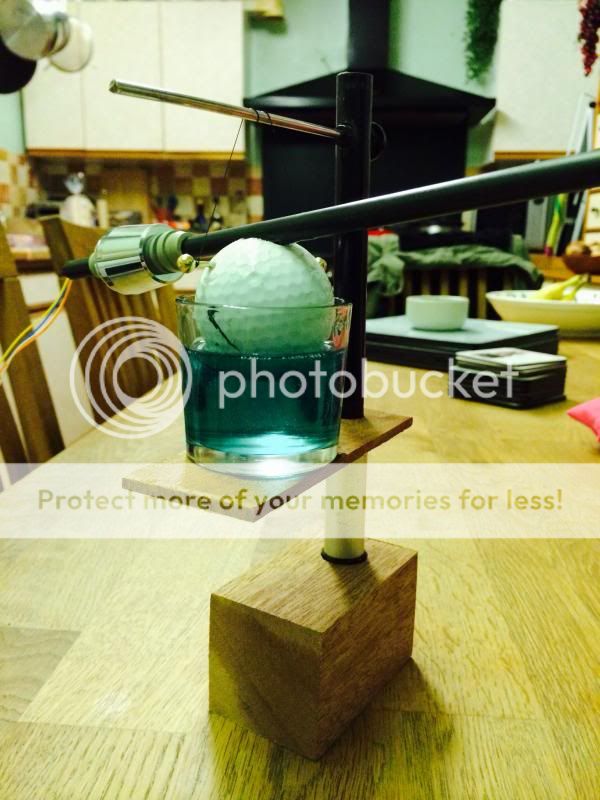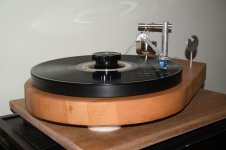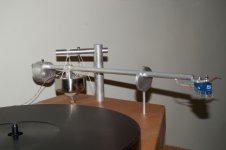Just Do It!
Here's my attempt built from bits and bobs found down the shed.

And in situe on the Home made "Turdtable" 🙂

Here's my attempt built from bits and bobs found down the shed.

And in situe on the Home made "Turdtable" 🙂

you boys have been busy, Im a bit jealous as i haven't done much with mine, still looking for a decent cup for the ball to fit into
you boys have been busy, Im a bit jealous as i haven't done much with mine, still looking for a decent cup for the ball to fit into
Mine was one of the wife's little T-light candle holders, perfect size, good and solid and, as it was in a drawer unused, I didn't have to rearrange the decor so that it wasn't missed 🙂
Just for completeness sake the rest of mine is made up of:
a broken carbon fibre tent pole (the main support stem)
a piece from a dead steam cleaner (the arm, the main chrome shaft of the cleaner was used for the legs of the 'Turdtable)
fishing line
Nike golf ball (Just Do It)
a tie pin
a couple of bits of scrap wood
an aluminium arrow shaft (18 inches)
mouse wire
the counter weight off an old TT arm
a couple of rubber grommits
a quantity of Lynx shower gel (according to the adds the girls will love it 🙂 and it smells lovely )
an old cartridge head that fits perfectly into the arrow shaft
A couple of hours playing on the kitchen table and another project ticked off the list. Oh and it sounds lovely. The fluid will be replaced eventually, it's just an experiment at the moment but it seems to work ok.
I have it plugged into a 5 into 1 phono selector and it's interesting to have the WTL and the Linn Basik running on the same record simutaneously then switching between the two arms to hear an instant comparison on how they play and sound. The WTL is slightly louder and definately more 'open' (the best way I can describe it).
The biggest plus that I have is that I tried it on a Rod Stewart album that I bought but had the worst warp in any record that I have. No other arm could deal with it. The WTL took it in its stride and Rods gravely raspings were heard once more.
It's different, it looks great, it plays very well and it adds a new dimension to the 'Turdtable' that I love.
If anyone is thinking about a DIY project then give this one a go. It's worth it.
Mine sounds great but has a habit of skipping on very loud orchestral stuff (Holst Mars for instance). I think it's due to using a relatively low compliance cartridge (Sumiko Blue Point 2) on what is a low mass arm. When it's not skipping it sounds really detailed and dynamic, with no distortion so I think the geometry is ok. Any thoughts, anyone?
Mine sounds great but has a habit of skipping on very loud orchestral stuff (Holst Mars for instance). I think it's due to using a relatively low compliance cartridge (Sumiko Blue Point 2) on what is a low mass arm. When it's not skipping it sounds really detailed and dynamic, with no distortion so I think the geometry is ok. Any thoughts, anyone?
A small weight on the cartridge holder. I had a similar problem on the homemade one on the Saturn and used a car wheel balancing weight others have used a small coin or similar. There will be a correct way to do this I'm sure 🙂
Id like to ask, How long does it take for your arms to drop i.e. if it were not positioned over the TT & allowed to drop down. As if queuing, Its my understanding that it should take a cple of seconds at least to do this, due to the viscosity of the fluid.
Id like to ask, How long does it take for your arms to drop i.e. if it were not positioned over the TT & allowed to drop down. As if queuing, Its my understanding that it should take a cple of seconds at least to do this, due to the viscosity of the fluid.
Jay & Mbray7,
My WTA was a clone of the first one that WT had on the market. Used it for years. The original as measured by me at a dealer's showroom, took about 10 seconds to drop from 1 inch to the record surface. The disk that was submerged in fluid had 2 holes spaced 180 deg apart. the disk was about 3/16" thk. The holes and their size were meant to control descent rate by providing a drain passage so the disk could easily move through the fluid. Of course this was all dependent on fluid viscosity. Does your disk have drain holes? If not, Remove the disk (MESSY) and drill a couple of 3/8" to 1/2" holes midway between the arm tube riser and the disk edge. You could also use a less viscous fluid. Additional weight should not be needed. The golf ball model uses the height of the fluid on the ball to control the amount of damping. I have no idea what the drop rate is for the golf ball. No reason why the disk could be adjusted to ride less than totally submerged.
Nice to see someone building the original. I didn't like the anti-skate setup on it though.
Rgds,
BillG
Last edited:
Thanks Bill, good reply.
Are you referring to the 'crossed over' thread that suspends the arm?
I knew it was a relevant question in as much as it's the viscosity of the fluid which is very important & if the Arm does not move slowly as it was designed to do then it won't have the damping it needs...
I was primarily interested in the Golf ball, as that is the way i'm going.
Are you referring to the 'crossed over' thread that suspends the arm?
I knew it was a relevant question in as much as it's the viscosity of the fluid which is very important & if the Arm does not move slowly as it was designed to do then it won't have the damping it needs...
I was primarily interested in the Golf ball, as that is the way i'm going.
Thanks Bill, good reply.
Are you referring to the 'crossed over' thread that suspends the arm?
I knew it was a relevant question in as much as it's the viscosity of the fluid which is very important & if the Arm does not move slowly as it was designed to do then it won't have the damping it needs...
I was primarily interested in the Golf ball, as that is the way i'm going.
Jay,
The original WTA had monofilament lines hanging the arm and arm support disk from the top of the gantry. Line was fastened to one side of the disk. Fastened to the underside of the gantry top was what looked a lot like a circle drawing compass. There was a hole in each of the compass legs through which the suspension line went. The line went up through one leg and down through the other leg and then to the opposite side of the disk. The amount of antiskate force was set by the distance apart the two compass legs were set. The lines really didn't cross each other, just got further apart for more antiskate and closer for less. A clever idea which didn't work out too well. No matter where one set the legs there was always too much anti-skate when only a very small amount if any was required. I redesigned it to eliminate the compass leg thingie.
Good luck with your WTA.
BillG
Thanks, Bill. I used 10000 cSt fluid and the disc is almost identical to the original but the descent is quite quick on my arm (i.e. I can't let go of the arm and let it descend on its own). Looks like I need to try some higher viscosity fluid.
Bill !
What is the angle between the axis joining the centers of the two holes of the disk and the wand ?
Please.
What is the angle between the axis joining the centers of the two holes of the disk and the wand ?
Please.
Ok ALL, The fluid.
10,000 cSt: have no idea what this means, the only viscosity I know about is 20W40 etc i.e. engine oil....
Who Has used aftermarket Fluid that works i.e. That has this desired dampening effect of the SLOW Decent.... & what was IT ? lets have a product name or relevant information as to how it can be obtained...
Bill,
It's good that you pointed out an issue with crossing of the thread, for the Anti skate.
I imagine that we will all have to differing degrees similar issues due to, arm length, weight, cartridge weight / position etc, All are variables
10,000 cSt: have no idea what this means, the only viscosity I know about is 20W40 etc i.e. engine oil....
Who Has used aftermarket Fluid that works i.e. That has this desired dampening effect of the SLOW Decent.... & what was IT ? lets have a product name or relevant information as to how it can be obtained...
Bill,
It's good that you pointed out an issue with crossing of the thread, for the Anti skate.
I imagine that we will all have to differing degrees similar issues due to, arm length, weight, cartridge weight / position etc, All are variables
That's the fluid I bought.So it's not viscous enough to provide a slow descent?
Does it depend on how much of the golf ball is in the silicone?
Does it depend on how much of the golf ball is in the silicone?
Marra, only to a small degree...I would imagine just below the strings...
some info found just now..
For silicone-oil i used 40.000 CPS oil from a toy shop (normally used with radio controlled cars). They had a lot of different values (10.000 / 20.000 / 40.000 / 80.000 / 100.000) and after experimenting with the 17.7" arm i found the 40.000 the best. The complete arm was fixed to a slab of granite with a stainless steel pin attached to it.
For the record, I had to special order 100,000 cSt silicone fluid. A 50 ml bottle is $10.
They also sourced 120,000 cSt, but couldn't determine the quantity in the bottles.
it's the same viscosity as the grease that's used for locking the differential in RC cars, the smallest bottle they sell at the local model car store is sufficient for two refills...
The fluid can indeed be bought from rc shops and the viscosity used is 100,000 units (not sure what the actual units are. Typically rc shops tend to cary a variety of viscosities from say 50,000 to 200,000 but well tempered uses 100,000 in its tonearms.
cheers ferns.
So it would seem that 10,000 is way to thin.....& somewhere around the 100,000 mark seems to be correct.
If peeps that have knowledge of what this fluid is, & quantities, by brand name, costs etc & what kind of outlets will sell it.
But Please also include where you are Ie USA, UK, or where ever.
e.g. isopropyl alcohol is readily available from Walgreens or just about anywhere on the whole of the US continent for 79cents per bottle.....Hear in England its just stupidly difficult to get.....
some info found just now..
For silicone-oil i used 40.000 CPS oil from a toy shop (normally used with radio controlled cars). They had a lot of different values (10.000 / 20.000 / 40.000 / 80.000 / 100.000) and after experimenting with the 17.7" arm i found the 40.000 the best. The complete arm was fixed to a slab of granite with a stainless steel pin attached to it.
For the record, I had to special order 100,000 cSt silicone fluid. A 50 ml bottle is $10.
They also sourced 120,000 cSt, but couldn't determine the quantity in the bottles.
it's the same viscosity as the grease that's used for locking the differential in RC cars, the smallest bottle they sell at the local model car store is sufficient for two refills...
The fluid can indeed be bought from rc shops and the viscosity used is 100,000 units (not sure what the actual units are. Typically rc shops tend to cary a variety of viscosities from say 50,000 to 200,000 but well tempered uses 100,000 in its tonearms.
cheers ferns.
So it would seem that 10,000 is way to thin.....& somewhere around the 100,000 mark seems to be correct.
If peeps that have knowledge of what this fluid is, & quantities, by brand name, costs etc & what kind of outlets will sell it.
But Please also include where you are Ie USA, UK, or where ever.
e.g. isopropyl alcohol is readily available from Walgreens or just about anywhere on the whole of the US continent for 79cents per bottle.....Hear in England its just stupidly difficult to get.....
I bought my fluid from Modelsport UK in Otley who hold a good range of Core-RC fluids for shock absorbers on model cars (10,000 cSt) and for differentials (100,000 cSt and upwards). I have just ordered some of the latter at under £5 for 60ml - my pot was a 60ml measuring cup from Asda and around 30ml covers the disc well. It just seems to be too loose with 10,000 cSt although the sound is still good, apart from some skipping on very loud orchestral sections.
Bill !
What is the angle between the axis joining the centers of the two holes of the disk and the wand ?
Please.
Arch,
I can't give you an actual angle, it will vary with the other parameters of your arm and setup. For starters rotate the disk so that at rest (Park position of the wand) there is no rotational force exerted on the wand. Moving the wand inwards to the center of the record will wind up the spring (string) causing the wand to return to rest when released. The closer to record center you get, the stronger will be the unwinding force. On an arm with an angled headshell the need for antiskate force is strongest at the beginning of the record and diminishes as you go toward the center. The force provided by the wand winding up the suspension strings from the zero force, rest position, actually gets stronger as the need for antiskate force reduces. It goes the wrong way. So now set the angle so that at rest there is still some force turning the arm outward to the edge of the record. As you rotate the wand inward on the record you will reducing the strength of your preset bias force. At some point it will reach the zero bias condition and start winding the spring up in the wrong direction. If you use a record with all the grooves sanded off you can watch this happening. The trick is to reach a condition where at the center of the music portion there is little or no motion of the arm in either direction and all the way across the record. The weight of the arm will help determine the unwinding force. The heavier the weight, the stronger the force. You may be able to fine tune the antiskate with a weight adjustment. I haven't done that so I can't comment on that one. Adjusting the viscosity of the fluid will also change the antiskate force, as will the amount of immersion of the disk or golf ball.
Note: To keep this all straight in our minds Skating drags the arm inward on the record. Anti-skating pushes it back outward.
In some of Bill Firebaugh's writings he states that very little antiskate force is needed for his WTAs. Nowhere is there any mention of the fact that the drag exerted by the silicone fluid on the disk/ball will vary with the pressure exerted by the ball/disk on the fluid. As I see it there is less skating force exerted by the wand/stylus at the end of the record than at the beginning. So this change in outward pressure (skating) reduces the drag and provides a continuous compensation for skating. Hence, as Firebaugh states there is little (not no) antiskating force required. for an analogy, picture how hard it is to walk through water rapidly than slowly.
So as a rule of thumb and an approximation, set the angle so that there is only a very mild outward bias on the arm at park.
Hopes this clears up some misunderstandings.
BillG
Bill,
It is now much clearer. In over 30 years of messing with hifi I hadn't realised the difference of skating & anti sk.......
mbray,
So in UK model shops, we look for, Core-RC fluids for differentials (100,000 cSt and upwards) 100,000 fluid.
Wouldn't it be interesting if those same passages of music tracked without skipping with the thicker fluid !
It is now much clearer. In over 30 years of messing with hifi I hadn't realised the difference of skating & anti sk.......
mbray,
So in UK model shops, we look for, Core-RC fluids for differentials (100,000 cSt and upwards) 100,000 fluid.
Wouldn't it be interesting if those same passages of music tracked without skipping with the thicker fluid !
Last edited:
- Status
- Not open for further replies.
- Home
- Source & Line
- Analogue Source
- My DIY WTL Tonearm

